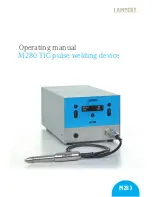
Viking 210GM, 250GM
2
ELECTRIC SHOCK
Electric Shock can injure or kill. The welding arc process uses and produces high voltage
electrical energy. This electric energy can cause severe or fatal shock to the operator or others in
the workplace.
•
Never touch any parts that are electrically “live” or “hot.”
•
Wear dry gloves and clothing. Insulate yourself from the work piece or other parts of the
welding circuit.
•
Repair or replace all worn or damaged parts.
•
Extra care must be taken when the workplace is moist or damp.
•
Install and maintain equipment according to NEC code, refer to item 4 in Subsection 1.3,
Publications.
•
Disconnect power source before performing any service or repairs.
•
Read and follow all the instructions in the Operating Manual.
FIRE AND EXPLOSION
Fire and explosion can be caused by hot slag, sparks, or the welding arc.
•
Be sure there is no combustible or flammable material in the workplace. Any material that
cannot be removed must be protected.
•
Ventilate all flammable or explosive vapors from the workplace.
•
Do not cut or weld on containers that may have held combustibles.
•
Provide a fire watch when working in an area where fire hazards may exist.
NOISE
Noise can cause permanent hearing loss. Plasma arc processes can cause noise levels to exceed
safe limits. You must protect your ears from loud noise to prevent permanent loss of hearing.
•
To protect your hearing from loud noise, wear protective ear plugs and/or ear muffs. Protect
others in the workplace.
•
Noise levels should be measured to be sure the decibels (sound) do not exceed safe levels.
•
For information on how to test for noise, see item 1 in Subsection 1.3, Publications, in this
manual.
ARC RAYS
Arc Rays can injure your eyes and burn your skin. The welding arc process produces very bright
ultra violet and infra red light. These arc rays will damage your eyes and burn your skin if you are
not properly protected.
•
To protect your eyes, always wear a welding helmet or shield. Also always wear safety glasses
with side shields, goggles or other protective eye wear.
•
Wear welding gloves and suitable clothing to protect your skin from the arc rays and sparks.
•
Keep helmet and safety glasses in good condition. Replace lenses when cracked, chipped or
dirty.
•
Protect others in the work area from the arc rays. Use protective booths, screens or shields.
•
Use the shade of lens as recommended in the Operating Manual.
Summary of Contents for Viking 210GM
Page 21: ...Viking 210GM 250GM 16 6 WELDING GUIDE VIKING 210GM...
Page 22: ...Viking 210GM 250GM 17 7 WELDING GUIDE VIKING 250GM...
Page 40: ...Viking 210GM 250GM 35 14 VIKING 210GM CIRCUIT DIAGRAM...
Page 41: ...Viking 210GM 250GM 36 15 VIKING 250GM CIRCUIT DIAGRAM...
Page 42: ...Viking 210GM 250GM 37 16 PRINTED CIRCUIT BOARD CIRCUIT DIAGRAM CAT NO 10 6100...








































